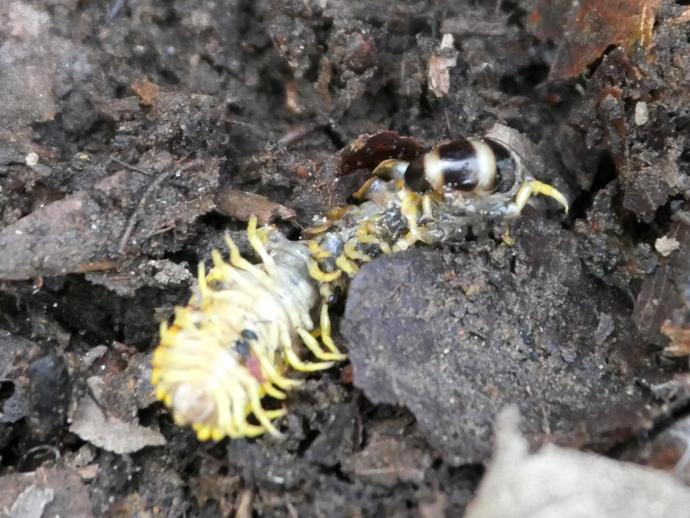November 27, 2020
We're reaching into the archives for today's #BenInNature update! The following post was originally published on April 18, 2020.
Today's nature update is something pretty cool (and gross!) that you don't see every day. It's also a two-for-one. Here we see two different insects: the yellow thing is a millipede that is having a sincerely bad day, and the shiny black thing that's where the millipede's head should be is a Phengodes larva. Phengodes is an extremely interesting genus of beetles. They belong to the beetle family Phengogidae, which are known as the "glow-worm beetles." The beetle larvae are bioluminescent, meaning that they glow in the dark! Phengodes larvae and larviform females (the females of this family still resemble larvae even when mature) are predators, and they love to eat millipedes.
So how do they do it? Well, you might want to finish your lunch before you find out. According to VMNH Research Technician and Millipede Expert Extraordinaire Dr. Jackson Means (who also identified this scene for me), once the Phengodes finds a millipede, it bites the membrane between the millipede's head and its first trunk segment -- basically the millipede equivalent of a neck. It then injects a toxin that paralyzes the millipede and stops it from releasing cyanide (you might remember from an earlier update that millipedes can release small amounts of cyanide as a chemical defense; it smells a bit like almonds or cherries). Once the millipede's defenses have been disabled, Phengodes removes the millipede's head and begins crawling through its body, eating as it goes, until it exits through the millipede's ... posterior. Ain't nature something?
ABOUT #BenInNature
Social distancing can be difficult, but it presents a great opportunity to become reacquainted with nature. In this series of posts, Administrator of Science Ben Williams ventures outdoors to record a snapshot of the unique sights that can be found in the natural world. New updates are posted Monday - Friday, with previous posts highlighted on the weekends.
NEW: TRIVIA CHALLENGE
You've seen the posts. You've learned the facts. Now, it's time to prove you are a #BenInNature Mega Fan! The museum's education team has developed the #BenInNature Trivia Challenge to identify the most devoted fans out there! Everyone who successfully answers each trivia question correctly will be congratulated by having your own nature selfie posted to the museum's #BenInNature Mega Fan Photo Album on the official VMNH Facebook page! Learn more and download the trivia challenge today by visiting www.vmnh.net/research-collections/beninnature-trivia-challenge.
NATURE PHOTO IDENTIFICATIONSIf you discover something in nature that you would like help identifying, be sure to message us right here on Facebook with a picture (please include location and date of picture) and we'll have our experts help you identify it!

 Hours & Admissions
Hours & Admissions Directions
Directions

